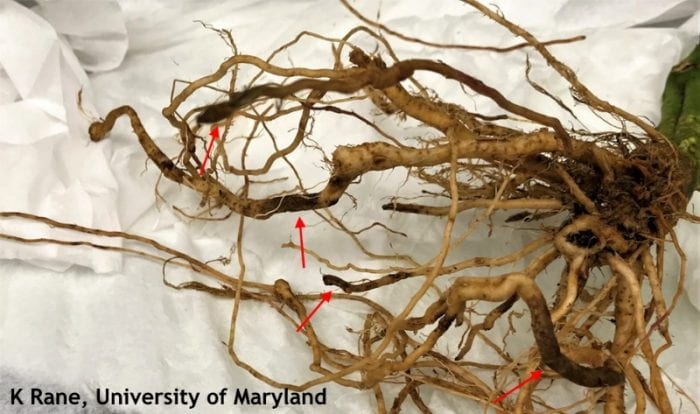Jerry Brust, IPM Vegetable Specialist, University of Maryland, jbrust@umd.edu; Ben Beale, St. Mary’s Co. Extension Agent, bbeale@umd.edu; Karen Rane, Plant Diagnostician, University of Maryland rane@umd.edu
Corky root is caused by the fungus Pyrenochaet lycopersici. Tomato plants affected with corky root may appear stunted and generally lack vigor. Later the infected plants may wilt during the day and recover at night, along with a slight yellowing and senescence of older leaves. Branches on mature plants may die back from the tips. Roots show dark brown, banded lesions (Fig. 1) with bark-like cracking and a loss of fine roots and cortex tissue. As the disease develops even the larger roots become infected and develop extensive brown lesions that are somewhat swollen and cracked along their length, giving them a corky appearance (Fig. 2). The disease is most commonly seen in tomato, but host range studies indicate that other vegetable crops, such as pepper, eggplant cucumber and melons, are susceptible.

Figure 1. Corky root disease on tomato roots showing dark brown banded lesions (arrows)

Figure 2. Corky root disease on tomato root showing dark lesion that is cracked and swollen
The corky root pathogen produces microsclerotia on the roots of host plants that can survive in the soil for up to 15 years. In the presence of a susceptible host the microsclerotia will germinate and infect host roots. Optimum soil temperatures for root infection are between 60-68oF, which means that most initial infections occur early in the growing season. Aboveground symptoms may not develop until later in the season when temperatures increase and the compromised root system cannot absorb enough water to meet plant needs.
Research has shown that reduced incidence of corky root disease is associated with use of plant -based composts (as opposed to composted manure) as well as lower concentrations of NH4-N and higher concentrations of calcium in the soil. Crop rotation out of solanaceous and cucurbit crops, and delaying planting until soils warm to 68°F, may also help in managing this disease, but these two cultural practices are not practical for most growers. For tomato, grafting scions onto corky root resistant rootstocks has been used effectively – there are several root stocks that give complete or high resistance to corky root disease listed at the vegetablegrafting.org website. For high tunnels the best management for the disease is probably either grafting or steam sterilization; the latter also gives the added benefits of reducing other soilborne diseases and weeds.
